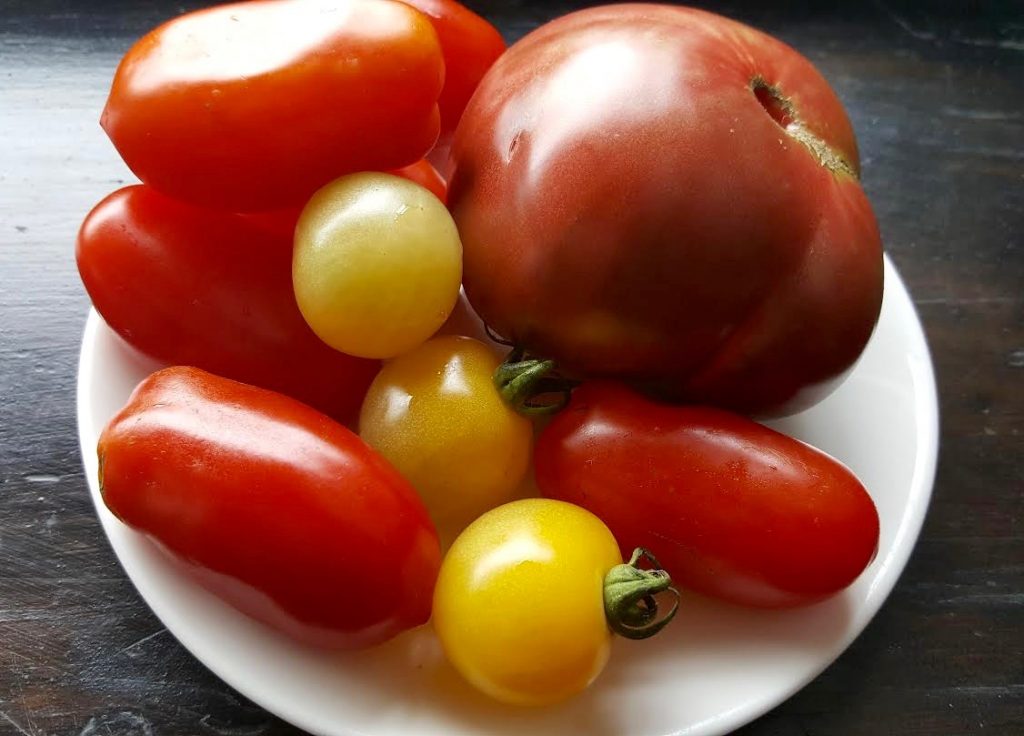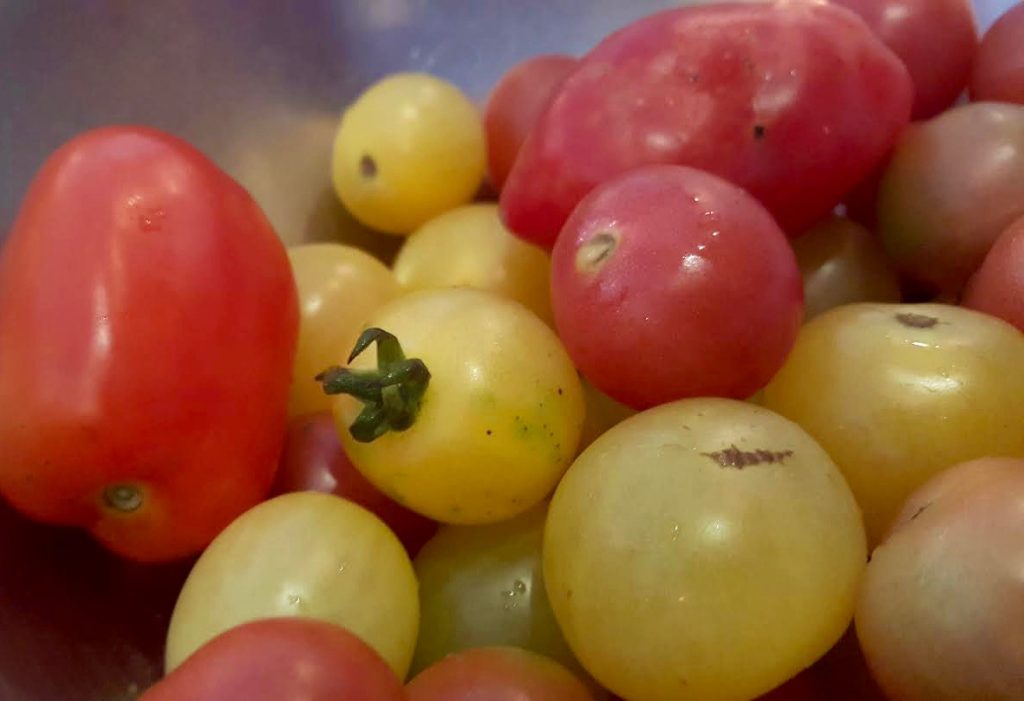
Heirloom tomatoes

A Black Crim (Crimea) tomato. Steve rates this the tastiest slicing tomato there is
By day STEVE HASKINS is a businessman. After hours he fulfils his passion for growing heirloom tomatoes on an allotment in Assagay. Here he explains his love of good coffee, food and the appeal of heirloom tomatoes. Once tasted… never forgotten.
I arrived in South Africa from Europe in the mid 70’s after having fled rightwing warmongering America. Ironic to end up in South Africa you say. Well, there is one thing worse than fascist fanatics waging never ending war, and that is a European winter. The allure of the “endless summer” brought me to South Africa in spite of the perils and politics of the time. Having arrived in Johannesburg in June it was like summer compared to what I had been through in Europe. Then, after arriving in Durban in July and going for a dip in the 23C water, I decided I was going to stay and try to survive. Avocados were R1 a dozen! I will try to survive.
One of my early experiences in Durban was to go to a well-known Italian restaurant on West Street called Aldos. I had spent a year in Italy and it was there I first experienced fine dining and true coffee. Being American I had been exposed to what was referred to as “Joe” – percolator coffee served in mugs in an endless cycle of refills. It was black and watery and it was all we knew.
In Italy I first experienced traditional Italian cooking and real coffee made in a simple stainless steel espresso pot. Chalk and cheese. The bars and cafes had pressurised espresso machines, but for home the simple espresso pot was the norm.
So going out to an “authentic” family Italian restaurant in Durban I naturally was looking forward to real Italian coffee, but was shocked to be served the standard of the time, a Frisco-type coffee substitute. Disappointed, I politely called over the owner, one of Aldo’s son’s and asked him why they didn’t serve proper Italian coffee. His reply was, “we did at first but the South Africans complained and turned up their noses. So we gave them what they wanted.”
So now 40 years later South Africans have changed their tastes and few choose the chicory that was then the prefered norm.
So what does this have to do with heirloom tomatoes you ask? Well, it’s about going back to a food’s origins and discovering authentic flavours.Tomatoes, as sold in most shops in South Africa, are one of the cheapest produce you can buy. It is the most basic ingredient for almost every form of cooking from chakalaka, to curry chutney to pasta sauces and pizza. It’s also used fresh in salads, of course. . The list of its uses is endless. Because of the great demand for tomatoes, farmers, using all the modern chemistry available, have developed a method of growing certain varieties of hybrid tomatoes that meet all the needs for growing and marketing except one … taste.
Tomatoes are a fruit. For a fruit to have flavour it has to stay on the tree, bush or vine long enough to develop the sugars that give the fruit its flavour, but to let this happen means it has to be picked when it is nearly ripe and, by the time it gets to the market place, it will ripen and spoil faster than profit-oriented stores require. Tomato farmers like varieties they can pick early and refrigerate just before shipping. They sometimes use special gases that make them ripen and turn red even though they aren’t ripe. The result is a tomato that is red, but totally flavourless.
Now the general public, having never tasted a true tomato flavour, do not question this as they just don’t know any better. Even the small gardener grows the same hybrid varieties that are chosen for resistance to disease and slow ripening as opposed to their colour and flavour. This amounts to a form of 3-D printing of your food.
Heirloom refers basically to a traditional variety of fruit or veg that has not been “tweaked” scientifically. The seeds are passed down from generation to generation in the different areas where they originated. This “tweaking” has reached the point where insecticides and herbicides are genetically infused into the plant and, subsequently, the fruit and veg they produce. The great GMO debate over profits before health and environment continues. But that is another subject.
I first experienced heirloom tomatoes at a farmers’ market in California in one of my annual returns to renew my accent and visit family. I was amazed at the different varieties, colours, sizes and flavours. Farmers’ markets are the home of artisan growers, cooks and bakers of modern and traditional foods not available in today’s mass produced food outlets. The produce usually cost a bit and sometimes a lot more, but this was about food, cooking and eating as entertainment. You were either impressed or wanted to impress others.
I brought some seeds back to South Africa and began growing in earnest about five years ago. I knew nothing and had no one to teach me either. The climate where I was growing was not ideal. Hot and humid and wet in the spring and summer. Tomatoes like hot, but not humid and wet summers.
Since I started there has been a small introduction of some heirloom varieties and some specialised shops like Woolies. Because they are priced at more than three times normal tomatoe prices they have not proved to be appealing. They also still lack the flavours of true vine ripened heirloom tomatoes.
So, until South Africans have the opportunity to taste and experience a true tomato experience, the heirloom tomato market will flounder apart from in the farmer’s market realm. I gave a British visitor one of the large Pineapple tomatoes I grew, to which they gaily replied it would have cost 4 UK pounds a kilo in England. In California they sell from $6.00 – $10.00 a kilo . Do the maths. That’s close to R100 a kilo.
Why pay so much you ask?? Once you have tasted the difference, there is no going back. Just like coffee. People are prepared to pay for what they want. The same food revolution is taking place with craft beers and artisan breads. Once you have experienced the real deal, you won’t accept a bland flavourless experience.
I have given some of my Indian friends some heirloom San Marzano plum tomatoes, sun ripened, to use for their chutney. They raved at the overwhelming flavour they experienced as opposed to the kind they normally buy from their local store. Heirloom tomatoes are a visual treat and a flavour experience. From cooking tomatoes like San Marzanos and Orange plums, slicing tomatoes like Black Crims, Peach, Yellow and Red Brandywines, to multi coloured cherry tomatoes. It’s only a matter of time. The only thing lacking is the supply to create the demand. You get what you pay for. So far, you won’t get it in a supermarket or mass market shop. Look for them in the open markets. It will be worth it I assure you. Tomato season has begun. – January 2017
What is an heirloom seed or plant?
Wikipedia defines it this way…
An heirloom plant, heirloom variety, heritage fruit (Australia and New Zealand), or (especially in Ireland and the UK) heirloom vegetable is an old cultivar that is maintained by gardeners and farmers, particularly in isolated or ethnic minority communities in western countries. These may have been commonly grown during earlier periods in human history, but are not used in modern large-scale agriculture. In some parts of the world, notably the European Union, it is illegal to sell seeds of cultivars that are not listed as approved for sale. The Henry Doubleday Research Association, now known as Garden Organic, responded to this legislation by setting up the Heritage Seed Library to preserve seeds of as many of the older cultivars as possible. However, seed banks alone have not been able to provide sufficient insurance against catastrophic loss. In some jurisdictions, laws have been proposed that would make seed saving itself illegal.
Many heirloom vegetables have kept their traits through open pollination, while fruit varieties such as apples have been propagated over the centuries through grafts and cuttings. The trend of growing heirloom plants in gardens has been returning in popularity in North America and Europe in recent decades.
